
Rev: 1.01c 11/2002
1/30
© 2001, Giga Semiconductor, Inc.
Specifications cited are subject to change without notice. For latest documentation see http://www.gsitechnology.com.
NoBL is a trademark of Cypress Semiconductor Corp.. NtRAM is a trademark of Samsung Electronics Co.. ZBT is a trademark of Integrated Device Technology, Inc.
GS841Z18/36AT-180/166/150/100
4Mb Pipelined and Flow Through
Synchronous NBT SRAMs
180 MHz≠100 MHz
3.3 V V
DD
2.5 V and 3.3 V V
DDQ
100-Pin TQFP
Commercial Temp
Industrial Temp
Preliminary
Features
∑ 256K x 18 and 128K x 36 configurations
∑ User-configurable Pipelined and Flow Through mode
∑ NBT (No Bus Turn Around) functionality allows zero wait
∑ Fully pin-compatible with both pipelined and flow through
NtRAMTM, NoBLTM and ZBTTM SRAMs
∑ IEEE 1149.1 JTAG-compatible Boundary Scan
∑ 3.3 V +10%/≠5% core power supply
∑ 2.5 V or 3.3 V I/O supply
∑ LBO pin for Linear or Interleave Burst mode
∑ Byte write operation (9-bit Bytes)
∑ 3 chip enable signals for easy depth expansion
∑ Clock Control, registered, address, data, and control
∑ ZZ Pin for automatic power-down
∑ JEDEC-standard 100-lead TQFP package
Functional Description
The GS841Z18/36AT is an 4Mbit Synchronous Static SRAM.
GSI's NBT SRAMs, like ZBT, NtRAM, NoBL or other
pipelined read/double late write or flow through read/single
late write SRAMs, allow utilization of all available bus
bandwidth by eliminating the need to insert deselect cycles
when the device is switched from read to write cycles.
Because it is a synchronous device, address, data inputs, and
read/ write control inputs are captured on the rising edge of the
input clock. Burst order control (LBO) must be tied to a power
rail for proper operation. Asynchronous inputs include the
Sleep mode enable (ZZ) and Output Enable. Output Enable can
be used to override the synchronous control of the output
drivers and turn the RAM's output drivers off at any time.
Write cycles are internally self-timed and initiated by the rising
edge of the clock input. This feature eliminates complex off-
chip write pulse generation required by asynchronous SRAMs
and simplifies input signal timing.
The GS841Z18/36AT may be configured by the user to
operate in Pipeline or Flow Through mode. Operating as a
pipelined synchronous device, in addition to the rising-edge-
triggered registers that capture input signals, the device
incorporates a rising-edge-triggered output register. For read
cycles, pipelined SRAM output data is temporarily stored by
the edge-triggered output register during the access cycle and
then released to the output drivers at the next rising edge of
clock.
The GS841Z18/36AT is implemented with GSI's high
performance CMOS technology and is available in a JEDEC-
Standard 100-pin TQFP package.
≠180
≠166
≠150
≠100
Pipeline
3-1-1-1
tCycle
t
KQ
I
DD
5.5 ns
3.2 ns
335 mA
6.0 ns
3.5 ns
310 mA
6.6 ns
3.8 ns
280 mA
10 ns
4.5 ns
190 mA
Flow
Through
2-1-1-1
t
KQ
tCycle
I
DD
8 ns
9.1 ns
210 mA
8.5 ns
10 ns
190 mA
10 ns
12 ns
165 mA
12 ns
15 ns
135 mA
A
B
C
D
E
F
R
W
R
W
R
W
Q
A
D
B
Q
C
D
D
Q
E
Q
A
D
B
Q
C
D
D
Q
E
Clock
Address
Read/Write
Flow Through
Data I/O
Pipelined
Data I/O
Flow Through and Pipelined NBT SRAM Back-to-Back Read/Write Cycles
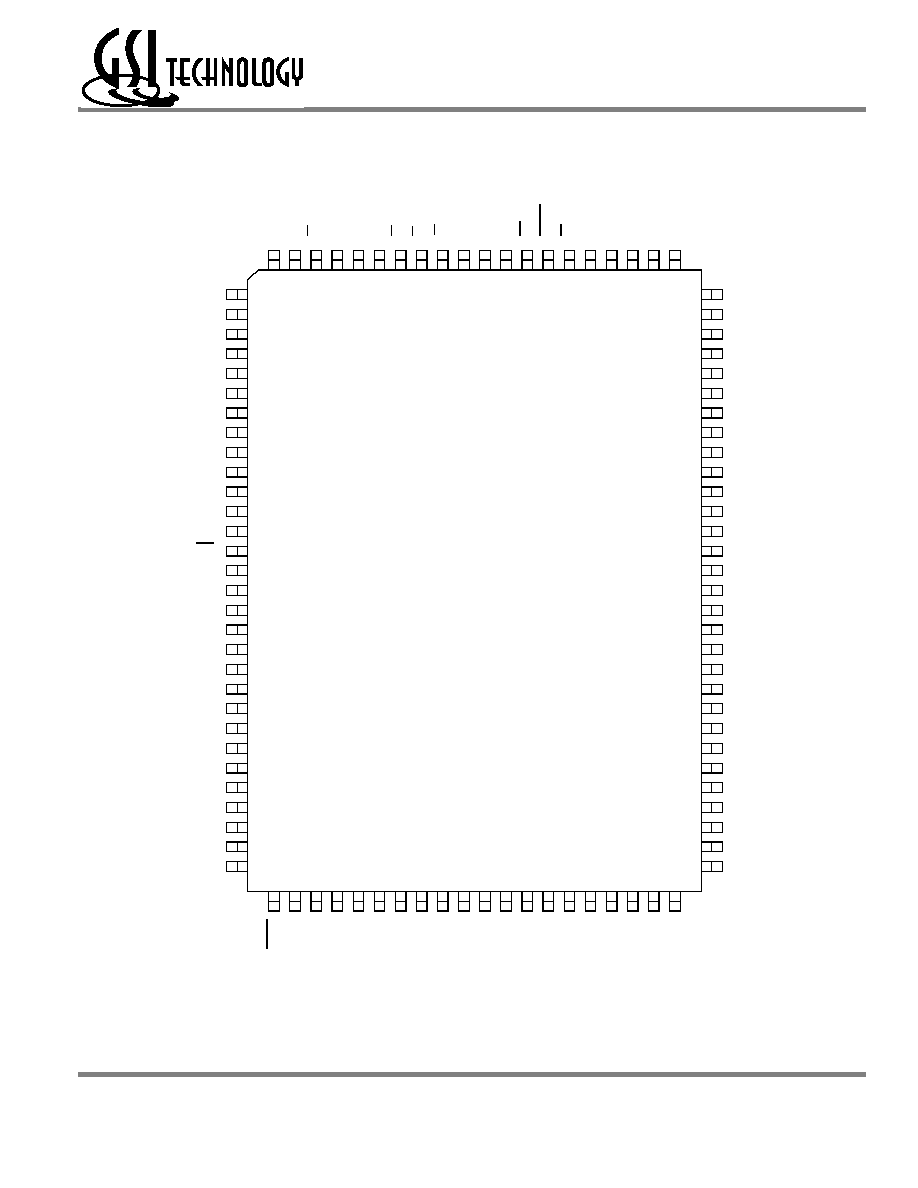
Rev: 1.01c 11/2002
2/30
© 2001, Giga Semiconductor, Inc.
Specifications cited are subject to change without notice. For latest documentation see http://www.gsitechnology.com
GS841Z18/36AT-180/166/150/100
Preliminary
GS841Z18AT Pinout
80
79
78
77
76
75
74
73
72
71
70
69
68
67
66
65
64
63
62
61
60
59
58
57
56
55
54
53
52
51
1
2
3
4
5
6
7
8
9
10
11
12
13
14
15
16
17
18
19
20
21
22
23
24
25
26
27
28
29
30
V
DDQ
V
SS
DQ
B1
DQ
B2
V
SS
V
DDQ
DQ
B3
DQ
B4
FT
V
DD
NC
V
SS
DQ
B5
DQ
B6
V
DDQ
V
SS
DQ
B7
DQ
B8
DQ
B9
V
SS
V
DDQ
V
DDQ
V
SS
DQ
A8
DQ
A7
V
SS
V
DDQ
DQ
A6
DQ
A5
V
SS
NC
V
DD
ZZ
DQ
A4
DQ
A3
V
DDQ
V
SS
DQ
A2
DQ
A1
V
SS
V
DDQ
LB
O
A
5
A
4
A
3
A
2
A
1
A
0
TMS
TD
I
V
SS
V
DD
TDO
TCK
A
10
A
11
A
12
A
13
A
14
A
16
A
6
A
7
E
1
E
2
NC
NC
B
B
B
A
E
3
CK
W
CKE
V
DD
V
SS
G
ADV
NC
NC
A
8
A
9
A
15
256K x 18
Top View
DQ
A9
A
17
NC
NC
NC
NC
NC
NC
NC
NC
NC
NC
NC
NC
NC
NC
NC
NC
NC
100 99 98 97 96 95 94 93 92 91 90 89 88 87 86 85 84 83 82 81
31 32 33 34 35 36 37 38 39 40 41 42 43 44 45 46 47 48 49 50

Rev: 1.01c 11/2002
3/30
© 2001, Giga Semiconductor, Inc.
Specifications cited are subject to change without notice. For latest documentation see http://www.gsitechnology.com
GS841Z18/36AT-180/166/150/100
Preliminary
GS841Z36AT Pinout
80
79
78
77
76
75
74
73
72
71
70
69
68
67
66
65
64
63
62
61
60
59
58
57
56
55
54
53
52
51
1
2
3
4
5
6
7
8
9
10
11
12
13
14
15
16
17
18
19
20
21
22
23
24
25
26
27
28
29
30
V
DDQ
V
SS
DQ
C4
DQ
C3
V
SS
V
DDQ
DQ
C2
DQ
C1
FT
V
DD
NC
V
SS
DQ
D1
DQ
D2
V
DDQ
V
SS
DQ
D3
DQ
D4
DQ
D5
V
SS
V
DDQ
V
DDQ
V
SS
DQ
B4
DQ
B3
V
SS
V
DDQ
DQ
B2
DQ
B1
V
SS
NC
V
DD
ZZ
DQ
A1
DQ
A2
V
DDQ
V
SS
DQ
A3
DQ
A4
V
SS
V
DDQ
LB
O
A
5
A
4
A
3
A
2
A
1
A
0
TMS
TDI
V
SS
V
DD
TD
O
TCK
A
10
A
11
A
12
A
13
A
14
A
16
A
6
A
7
E
1
E
2
B
D
B
C
B
B
B
A
E
3
CK
W
CKE
V
DD
V
SS
G
ADV
NC
NC
A
8
A
9
A
15
128K x 36
Top View
DQ
B5
DQ
B9
DQ
B7
DQ
B8
DQ
B6
DQ
A6
DQ
A5
DQ
A8
DQ
A7
DQ
A9
DQ
C7
DQ
C8
DQ
C6
DQ
D6
DQ
D8
DQ
D7
DQ
D9
DQ
C5
DQ
C9
100 99 98 97 96 95 94 93 92 91 90 89 88 87 86 85 84 83 82 81
31 32 33 34 35 36 37 38 39 40 41 42 43 44 45 46 47 48 49 50
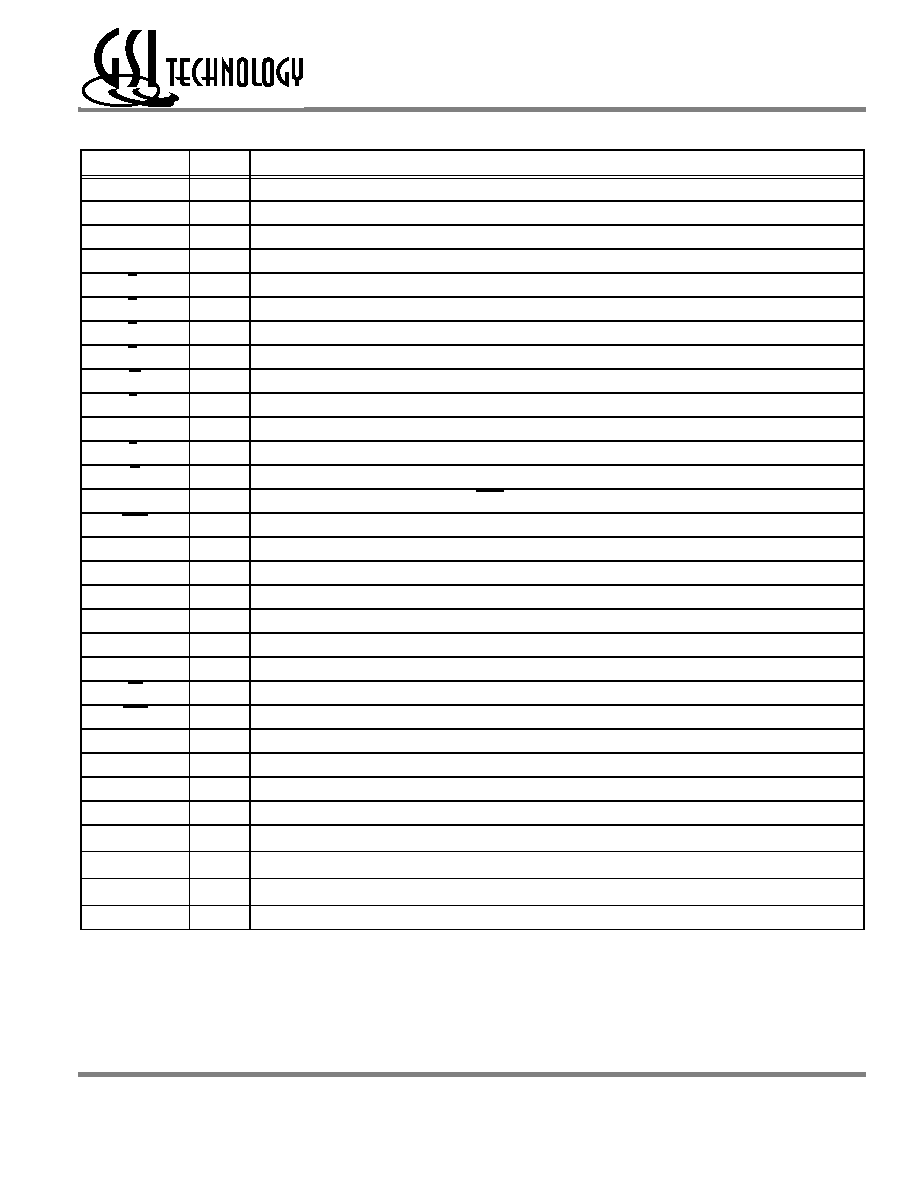
Rev: 1.01c 11/2002
4/30
© 2001, Giga Semiconductor, Inc.
Specifications cited are subject to change without notice. For latest documentation see http://www.gsitechnology.com
GS841Z18/36AT-180/166/150/100
Preliminary
100-Pin TQFP Pin Descriptions
Symbol
Type
Description
A
0
, A
1
In
Burst Address Inputs--Preload the burst counter
A
2
≠A
16
In
Address Inputs
A
17
In
Address Input
CK
In
Clock Input Signal
B
A
In
Byte Write signal for data inputs DQ
A1
≠DQ
A9
; active low
B
B
In
Byte Write signal for data inputs DQ
B1
≠DQ
B9
; active low
B
C
In
Byte Write signal for data inputs DQ
C1
≠DQ
C9
; active low
B
D
In
Byte Write signal for data inputs DQ
D1
≠DQ
D9
; active low
W
In
Write Enable; active low
E
1
In
Chip Enable; active low
E
2
In
Chip Enable; active high; for self decoded depth expansion
E
3
In
Chip Enable; active low; for self decoded depth expansion
G
In
Output Enable; active low
ADV
In
Advance / Load--Burst address counter control pin
CKE
In
Clock Input Buffer Enable; active low
NC
--
No Connect
DQ
A1
≠DQ
A9
I/O
Byte A Data Input and Output pins
DQ
B1
≠DQ
B9
I/O
Byte B Data Input and Output pins
DQ
C1
≠DQ
C9
I/O
Byte C Data Input and Output pins
DQ
D1
≠DQ
D9
I/O
Byte D Data Input and Output pins
ZZ
In
Power down control; active high
FT
In
Pipeline/Flow Through Mode Control; active low
LBO
In
Linear Burst Order; active low
TMS
--
Scan Test Mode Select
TDI
--
Scan Test Data In
TDO
--
Scan Test Data Out
TCK
--
Scan Test Clock
V
DD
In
3.3 V power supply
V
SS
In
Ground
V
DDQ
In
3.3 V output power supply for noise reduction
NC
--
No Connect

Rev: 1.01c 11/2002
5/30
© 2001, Giga Semiconductor, Inc.
Specifications cited are subject to change without notice. For latest documentation see http://www.gsitechnology.com
GS841Z18/36AT-180/166/150/100
Preliminary
Functional Details
Clocking
Deassertion of the Clock Enable (CKE) input blocks the Clock input from reaching the RAM's internal circuits. It may be used to
suspend RAM operations. Failure to observe Clock Enable set-up or hold requirements will result in erratic operation.
Pipeline Mode Read and Write Operations
All inputs (with the exception of Output Enable, Linear Burst Order and Sleep) are synchronized to rising clock edges. Single cycle
read and write operations must be initiated with the Advance/Load pin (ADV) held low, in order to load the new address. Device
activation is accomplished by asserting all three of the Chip Enable inputs (E
1
, E
2,
and E
3
). Deassertion of any one of the Enable
inputs will deactivate the device.
Read operation is initiated when the following conditions are satisfied at the rising edge of clock: CKE is asserted Low, all three
chip enables (E1, E2, and E3) are active, the write enable input signals W is deasserted high, and ADV is asserted low. The address
presented to the address inputs is latched in to address register and presented to the memory core and control logic. The control
logic determines that a read access is in progress and allows the requested data to propagate to the input of the output register. At
the next rising edge of clock the read data is allowed to propagate through the output register and onto the Output pins.
Write operation occurs when the RAM is selected, CKE is active and the Write input is sampled low at the rising edge of clock.
The Byte Write Enable inputs (B
A
, B
B
, B
C,
and B
D
) determine which bytes will be written. All or none may be activated. A Write
Cycle with no Byte Write inputs active is a no-op cycle. The pipelined NBT SRAM provides double late write functionality,
matching the write command versus data pipeline length (2 cycles) to the read command versus data pipeline length (2 cycles). At
the first rising edge of clock, Enable, Write, Byte Write(s), and Address are registered. The Data In associated with that address is
required at the third rising edge of clock.
Flow Through Mode Read and Write Operations
Operation of the RAM in Flow Through mode is very similar to operations in Pipeline mode. Activation of a Read Cycle and the
use of the Burst Address Counter is identical. In Flow Through mode the device may begin driving out new data immediately after
new address are clocked into the RAM, rather than holding new data until the following (second) clock edge. Therefore, in Flow
Through mode the read pipeline is one cycle shorter than in Pipeline mode.
Write operations are initiated in the same way as well, but differ in that the write pipeline is one cycle shorter, preserving the ability
to turn the bus from reads to writes without inserting any dead cycles. While the pipelined NBT RAMs implement a double late
write protocol, in Flow Through mode a single late write protocol mode is observed. Therefore, in Flow Through mode, address
and control are registered on the first rising edge of clock and data in is required at the data input pins at the second rising edge of
clock.
Function
W
B
A
B
B
B
C
B
D
Read
H
X
X
X
X
Write Byte "a"
L
L
H
H
H
Write Byte "b"
L
H
L
H
H
Write Byte "c"
L
H
H
L
H
Write Byte "d"
L
H
H
H
L
Write all Bytes
L
L
L
L
L
Write Abort/NOP
L
H
H
H
H

Rev: 1.01c 11/2002
6/30
© 2001, Giga Semiconductor, Inc.
Specifications cited are subject to change without notice. For latest documentation see http://www.gsitechnology.com
GS841Z18/36AT-180/166/150/100
Preliminary
Synchronous Truth Table
Operation
Type Address E
1
E
2
E
3
ZZ ADV W Bx G CKE CK
DQ
Notes
Deselect Cycle, Power Down
D
None
H
X
X
L
L
X
X
X
L
L-H High-Z
Deselect Cycle, Power Down
D
None
X
X
H
L
L
X
X
X
L
L-H High-Z
Deselect Cycle, Power Down
D
None
X
L
X
L
L
X
X
X
L
L-H High-Z
Deselect Cycle, Continue
D
None
X
X
X
L
H
X
X
X
L
L-H High-Z
1
Read Cycle, Begin Burst
R
External
L
H
L
L
L
H
X
L
L
L-H
Q
Read Cycle, Continue Burst
B
Next
X
X
X
L
H
X
X
L
L
L-H
Q
1,10
NOP/Read, Begin Burst
R
External
L
H
L
L
L
H
X
H
L
L-H High-Z
2
Dummy Read, Continue Burst
B
Next
X
X
X
L
H
X
X
H
L
L-H High-Z
1,2,10
Write Cycle, Begin Burst
W
External
L
H
L
L
L
L
L
X
L
L-H
D
3
Write Cycle, Continue Burst
B
Next
X
X
X
L
H
X
L
X
L
L-H
D
1,3,10
NOP/Write Abort, Begin Burst
W
None
L
H
L
L
L
L
H
X
L
L-H High-Z
2,3
Write Abort, Continue Burst
B
Next
X
X
X
L
H
X
H
X
L
L-H High-Z 1,2,3,10
Clock Edge Ignore, Stall
Current
X
X
X
L
X
X
X
X
H
L-H
-
4
Sleep Mode
None
X
X
X
H
X
X
X
X
X
X
High-Z
Notes:
1. Continue Burst cycles, whether read or write, use the same control inputs; a Deselect continue cycle can only be entered into if a Deselect
cycle is executed first
2. Dummy read and write abort can be considered NOPs because the SRAM performs no operation. A Write abort occurs when the W pin is
sampled low but no Byte Write pins are active, so no Write operation is performed.
3. G can be wired low to minimize the number of control signals provided to the SRAM. Output drivers will automatically turn off during Write
cycles.
4. If CKE High occurs during a pipelined read cycle, the DQ bus will remain active (Low Z). If CKE High occurs during a write cycle, the bus
will remain in High Z.
5. X = Don't Care; H = Logic High; L = Logic Low; Bx = High = All Byte Write signals are high; Bx = Low = One or more Byte/Write signals
are Low
6. All inputs, except G and ZZ must meet setup and hold times of rising clock edge.
7. Wait states can be inserted by setting CKE high.
8. This device contains circuitry that ensures all outputs are in High Z during power-up.
9. A 2-bit burst counter is incorporated.
10. The address counter is incriminated for all Burst continue cycles.
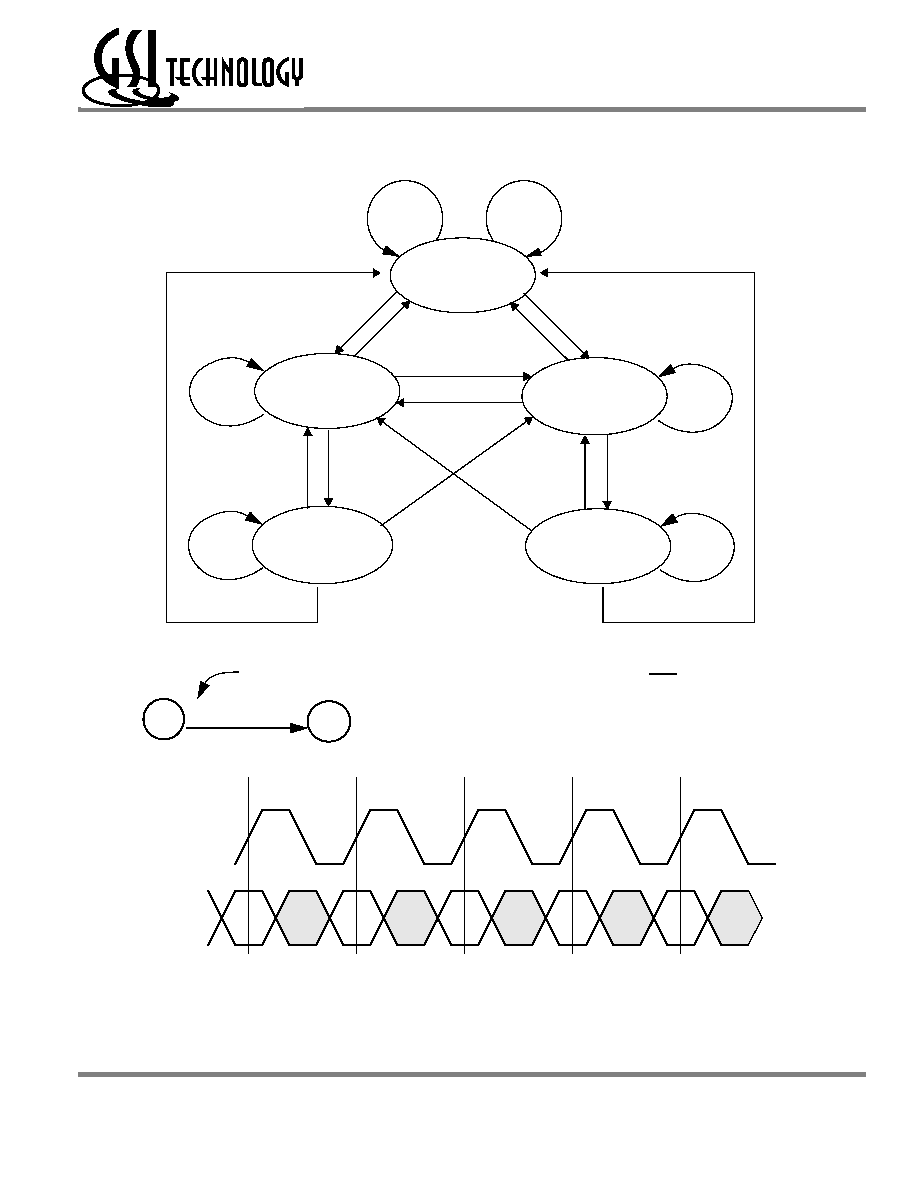
Rev: 1.01c 11/2002
7/30
© 2001, Giga Semiconductor, Inc.
Specifications cited are subject to change without notice. For latest documentation see http://www.gsitechnology.com
GS841Z18/36AT-180/166/150/100
Preliminary
Deselect
New Read
New Write
Burst Read
Burst Write
W
R
B
R
B
W
D
D
B
B
W
R
D
B
W
R
D
D
Pipeline and Flow Through Read-Write Control State Diagram
Current State (n)
Next State (n+1)
Transition
Input Command Code
Key
Notes
1. The Hold command (CKE Low) is not
shown because it prevents any state change.
2. W, R, B and D represent input command
codes, as indicated in the Synchronous Truth Table.
Clock (CK)
Command
Current State
Next State
n
n+1
n+2
n+3
Current State and Next State Definition for
Pipelined and Flow Through Read/Write Control State Diagram
W
R
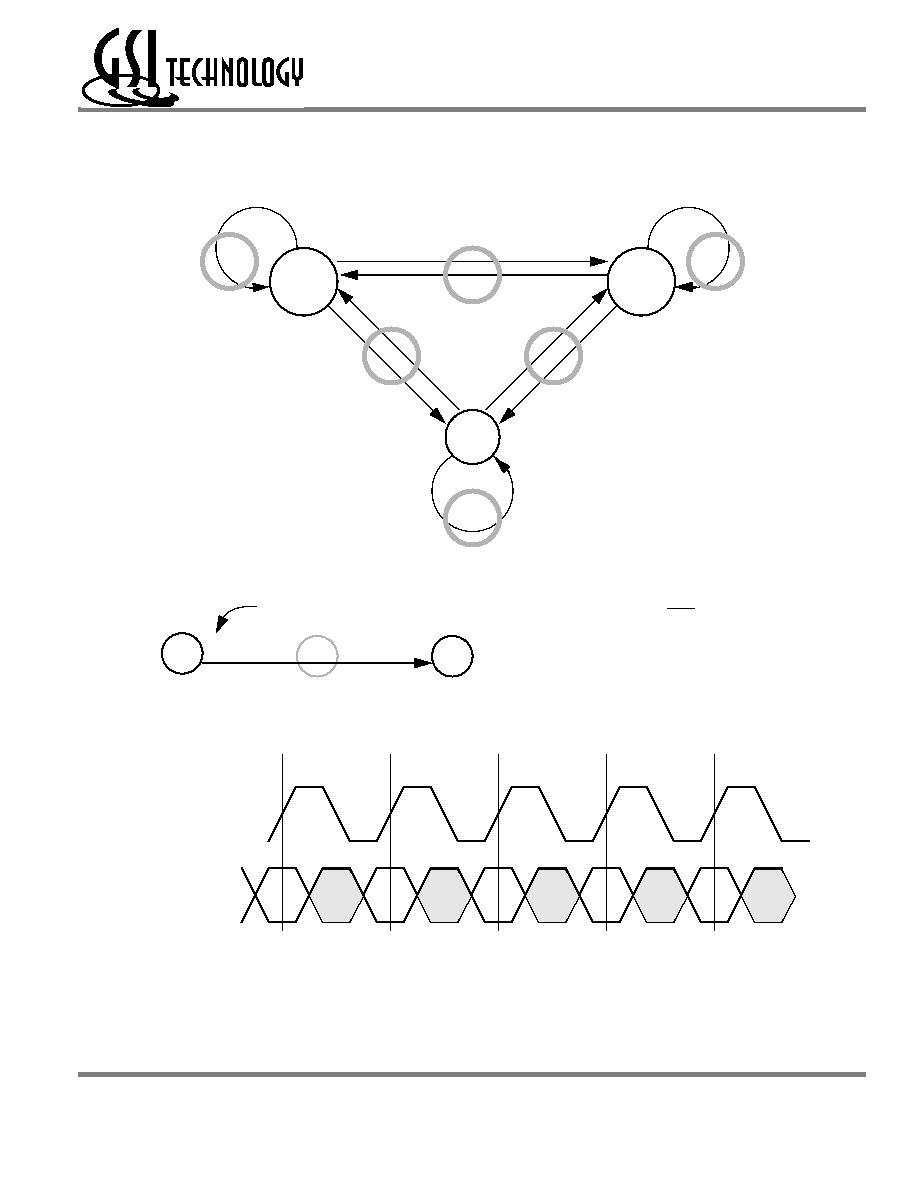
Rev: 1.01c 11/2002
8/30
© 2001, Giga Semiconductor, Inc.
Specifications cited are subject to change without notice. For latest documentation see http://www.gsitechnology.com
GS841Z18/36AT-180/166/150/100
Preliminary
Intermediate
Intermediate
Intermediate
Intermediate
Intermediate
Intermediate
High Z
(Data In)
Data Out
(Q Valid)
High Z
B W
B
R
B
D
R
W
R
W
D
D
Pipeline Mode Data I/O State Diagram
Current State (n)
Next State (n+2)
Transition
Input Command Code
Key
Transition
Intermediate State (N+1)
Notes
1. The Hold command (CKE Low) is not
shown because it prevents any state change.
2. W, R, B, and D represent input command
codes as indicated in the Truth Tables.
Clock (CK)
Command
Current State
Intermediate
n
n+1
n+2
n+3
Current State and Next State Definition for
Pipeline Mode Data I/O State Diagram
Next State
State

Rev: 1.01c 11/2002
9/30
© 2001, Giga Semiconductor, Inc.
Specifications cited are subject to change without notice. For latest documentation see http://www.gsitechnology.com
GS841Z18/36AT-180/166/150/100
Preliminary
High Z
(Data In)
Data Out
(Q Valid)
High Z
B W
B
R
B
D
R
W
R
W
D
D
Current State (n)
Next State (n+1)
Transition
Input Command Code
Key
Notes
1. The Hold command (CKE Low) is not
shown because it prevents any state change.
2. W, R, B, and D represent input command
codes as indicated in the Truth Tables.
Flow Through Mode Data I/O State Diagram
Clock (CK)
Command
Current State
Next State
n
n+1
n+2
n+3
Current State and Next State Definition for:
Pipeline and Flow Through Read Write Control State Diagram

Rev: 1.01c 11/2002
10/30
© 2001, Giga Semiconductor, Inc.
Specifications cited are subject to change without notice. For latest documentation see http://www.gsitechnology.com
GS841Z18/36AT-180/166/150/100
Preliminary
Burst Cycles
Although NBT RAMs are designed to sustain 100% bus bandwidth by eliminating turnaround cycle when there is transition from
read to write, multiple back-to-back reads or writes may also be performed. NBT SRAMs provide an on-chip burst address
generator that can be utilized, if desired, to further simplify burst read or write implementations. The ADV control pin, when
driven high, commands the SRAM to advance the internal address counter and use the counter generated address to read or write
the SRAM. The starting address for the first cycle in a burst cycle series is loaded into the SRAM by driving the ADV pin low, into
Load mode.
Burst Order
The burst address counter wraps around to its initial state after four addresses (the loaded address and three more) have been
accessed. The burst sequence is determined by the state of the Linear Burst Order pin (LBO). When this pin is Low, a linear burst
sequence is selected. When the RAM is installed with the LBO pin tied high, Interleaved burst sequence is selected. See the tables
below for details.
Note:
There are pull-up devices on the LBO and FT pins and a pull down device on the ZZ pin, so those input pins can be unconnected and the chip will
operate in the default states as specified in the above table.
Burst Counter Sequences
BPR 1999.05.18
Sleep Mode
During normal operation, ZZ must be pulled low, either by the user or by its internal pull down resistor. When ZZ is pulled high,
the SRAM will enter a Power Sleep mode after 2 cycles. At this time, internal state of the SRAM is preserved. When ZZ returns to
low, the SRAM operates normally after 2 cycles of wake up time.
Sleep mode is a low current, power-down mode in which the device is deselected and current is reduced to I
SB
2. The duration of
Mode Pin Functions
Mode Name
Pin Name
State
Function
Burst Order Control
LBO
L
Linear Burst
H or NC
Interleaved Burst
Output Register Control
FT
L
Flow Through
H or NC
Pipeline
Power Down Control
ZZ
L or NC
Active
H
Standby, I
DD
= I
SB
Linear Burst Sequence
Note: The burst counter wraps to initial state on the 5th clock.
I
nterleaved Burst Sequence
Note: The burst counter wraps to initial state on the 5th clock.
A[1:0]
A[1:0]
A[1:0]
A[1:0]
1st address
00
01
10
11
2nd address
01
10
11
00
3rd address
10
11
00
01
4th address
11
00
01
10
A[1:0]
A[1:0]
A[1:0]
A[1:0]
1st address
00
01
10
11
2nd address
01
00
11
10
3rd address
10
11
00
01
4th address
11
10
01
00

Rev: 1.01c 11/2002
11/30
© 2001, Giga Semiconductor, Inc.
Specifications cited are subject to change without notice. For latest documentation see http://www.gsitechnology.com
GS841Z18/36AT-180/166/150/100
Preliminary
Sleep mode is dictated by the length of time the ZZ is in a High state. After entering Sleep mode, all inputs except ZZ become
disabled and all outputs go to High-Z The ZZ pin is an asynchronous, active high input that causes the device to enter Sleep mode.
When the ZZ pin is driven high, I
SB
2 is guaranteed after the time tZZI is met. Because ZZ is an asynchronous input, pending
operations or operations in progress may not be properly completed if ZZ is asserted. Therefore, Sleep mode must not be initiated
until valid pending operations are completed. Similarly, when exiting Sleep mode during tZZR, only a Deselect or Read commands
may be applied while the SRAM is recovering from Sleep mode.
Sleep Mode Timing Diagram
Designing for Compatibility
The GSI NBT SRAMs offer users a configurable selection between Flow Through mode and Pipeline mode via the FT signal found
on Pin 14. Not all vendors offer this option, however most mark Pin 14 as V
DD
or V
DDQ
on pipelined parts and V
SS
on flow
through parts. GSI NBT SRAMs are fully compatible with these sockets.
Pin 66, a No Connect (NC) on GSI's GS880Z18/36 NBT SRAM, the Parity Error open drain output on GSI's GS881Z18/36 NBT
SRAM, is often marked as a power pin on other vendor's NBT-compatible SRAMs. Specifically, it is marked V
DD
or V
DDQ
on
pipelined parts and V
SS
on flow through parts. Users of GSI NBT devices who are not actually using the ByteSafeTM parity feature
may want to design the board site for the RAM with Pin 66 tied high through a 1k ohm resistor in Pipeline mode applications or
tied low in Flow Through mode applications in order to keep the option to use non-configurable devices open. By using the pull-up
resistor, rather than tying the pin to one of the power rails, users interested in upgrading to GSI's ByteSafe NBT SRAMs
(GS881Z18/36), featuring Parity Error detection and JTAG Boundary Scan, will be ready for connection to the active low, open
drain Parity Error output driver at Pin 66 on GSI's TQFP ByteSafe RAMs.
CK
ZZ
tZZR
tZZH
tZZS
~ ~
~ ~
Sleep

Rev: 1.01c 11/2002
12/30
© 2001, Giga Semiconductor, Inc.
Specifications cited are subject to change without notice. For latest documentation see http://www.gsitechnology.com
GS841Z18/36AT-180/166/150/100
Preliminary
Note:
Permanent damage to the device may occur if the Absolute Maximum Ratings are exceeded. Operation should be restricted to Recommended
Operating Conditions. Exposure to conditions exceeding the Absolute Maximum Ratings, for an extended
period of time, may affect reliability of this component.
Notes:
1. Unless otherwise noted, all performance specifications quoted are evaluated for worst case at both 2.75 V
V
DDQ
2.375 V
(i.e., 2.5 V I/O) and 3.6 V
V
DDQ
3.135 V (i.e., 3.3 V I/O), and quoted at whichever condition is worst case.
2. This device features input buffers compatible with both 3.3 V and 2.5 V I/O drivers.
3. Most speed grades and configurations of this device are offered in both Commercial and Industrial Temperature ranges. The part number of
Industrial Temperature Range versions end the character "I". Unless otherwise noted, all performance specifications quoted are evaluated
for worst case in the temperature range marked on the device.
4. Input Under/overshoot voltage must be ≠2 V > Vi < V
DD
+2 V with a pulse width not to exceed 20% tKC.
Absolute Maximum Ratings
(All voltages reference to V
SS
)
Symbol
Description
Value
Unit
V
DD
Voltage on V
DD
Pins
≠0.5 to 4.6
V
V
DDQ
Voltage in V
DDQ
Pins
≠0.5 to V
DD
V
V
CK
Voltage on Clock Input Pin
≠0.5 to 6
V
V
I/O
Voltage on I/O Pins
≠0.5 to V
DDQ
+0.5 (
4.6 V max.)
V
V
IN
Voltage on Other Input Pins
≠0.5 to V
DD
+0.5 (
4.6 V max.)
V
I
IN
Input Current on Any Pin
+/≠20
mA
I
OUT
Output Current on Any I/O Pin
+/≠20
mA
P
D
Package Power Dissipation
1.5
W
T
STG
Storage Temperature
≠55 to 125
o
C
T
BIAS
Temperature Under Bias
≠55 to 125
o
C
Recommended Operating Conditions
Parameter
Symbol
Min.
Typ.
Max.
Unit
Notes
Supply Voltage
V
DD
3.135
3.3
3.6
V
I/O Supply Voltage
V
DDQ
2.375
2.5
V
DD
V
1
Input High Voltage
V
IH
1.7
--
V
DD
+0.3
V
2
Input Low Voltage
V
IL
≠0.3
--
0.8
V
2
Ambient Temperature (Commercial Range Versions)
T
A
0
25
70
∞
C
3
Ambient Temperature (Industrial Range Versions)
T
A
≠40
25
85
∞
C
3

Rev: 1.01c 11/2002
13/30
© 2001, Giga Semiconductor, Inc.
Specifications cited are subject to change without notice. For latest documentation see http://www.gsitechnology.com
GS841Z18/36AT-180/166/150/100
Preliminary
Note: These parameters are sample tested.
Notes:
1. Junction temperature is a function of SRAM power dissipation, package thermal resistance, mounting board temperature, ambient.
Temperature air flow, board density, and PCB thermal resistance.
2. SCMI G-38-87
3. Average thermal resistance between die and top surface, MIL SPEC-883, Method 1012.1
Capacitance
(T
A
= 25
o
C, f = 1 MH
Z
, V
DD
= 3.3 V)
Parameter
Symbol
Test conditions
Typ.
Max.
Unit
Input Capacitance
C
IN
V
IN
= 0 V
4
5
pF
Input/Output Capacitance
C
I/O
V
OUT
= 0 V
6
7
pF
Package Thermal Characteristics
Rating
Layer Board
Symbol
Max
Unit
Notes
Junction to Ambient (at 200 lfm)
single
R
JA
40
∞
C/W
1,2
Junction to Ambient (at 200 lfm)
four
R
JA
24
∞
C/W
1,2
Junction to Case (TOP)
--
R
JC
9
∞
C/W
3
20% tKC
V
SS
≠ 2.0 V
50%
V
SS
V
IH
Undershoot Measurement and Timing
Overshoot Measurement and Timing
20% tKC
V
DD
+ 2.0 V
50%
V
DD
V
IL

Rev: 1.01c 11/2002
14/30
© 2001, Giga Semiconductor, Inc.
Specifications cited are subject to change without notice. For latest documentation see http://www.gsitechnology.com
GS841Z18/36AT-180/166/150/100
Preliminary
Notes:
1. Include scope and jig capacitance.
2. Test conditions as specified with output loading as shown in Fig. 1 unless otherwise noted.
3. Output Load 2 for t
LZ
, t
HZ
, t
OLZ
and t
OHZ
4. Device is deselected as defined by the Truth Table.
AC Test Conditions
Parameter
Conditions
Input high level
2.3 V
Input low level
0.2 V
Input slew rate
1 V/ns
Input reference level
1.25 V
Output reference level
1.25 V
Output load
Fig. 1& 2
DC Electrical Characteristics
Parameter
Symbol
Test Conditions
Min
Max
Input Leakage Current
(except mode pins)
I
IL
V
IN
= 0 to V
DD
≠1 uA
1 uA
ZZ Input Current
I
INZZ
V
DD
V
IN
V
IH
0 V
V
IN
V
IH
≠1 uA
≠1 uA
1 uA
300 uA
Mode Pin Input Current
I
INM
V
DD
V
IN
V
IL
0 V
V
IN
V
IL
≠300 uA
≠1 uA
1 uA
1 uA
Output Leakage Current
I
OL
Output Disable,
V
OUT
= 0 to V
DD
≠1 uA
1 uA
Output High Voltage
V
OH
I
OH
= ≠ mA, V
DDQ
= 2.375 V
1.7 V
--
Output High Voltage
V
OH
I
OH
= ≠ mA, V
DDQ
= 3.135 V
2.4 V
--
Output Low Voltage
V
OL
I
OL
= 8 mA
--
0.4 V
DQ
VT = 1.25 V
50
30pF
*
DQ
2.5 V
Output Load 1
Output Load 2
225
225
5pF
*
* Distributed Test Jig Capacitance

Rev: 1.01c 11/2002
15/30
© 2001, Giga Semiconductor, Inc.
Specifications cited are subject to change without notice. For latest documentation see http://www.gsitechnology.com
GS841Z18/36AT-180/166/150/100
Preliminary
Operating Currents
Parameter Test Conditions Symbol
-
180
-
166
-
150
-
100
Unit
0 to
70∞C
≠40 to
85∞C
0 to
70∞C
≠40 to
85∞C
0 to
70∞C
≠40 to
85∞C
0 to
70∞C
≠40 to
85∞C
Operating
Current
Device Selected;
All other inputs
V
IH
or
V
IL
Output open
I
DD
Pipeline
335
345
310
320
280
290
190
200
mA
I
DD
Flow-Thru
210
220
190
200
165
175
135
145
mA
Standby
Current
ZZ
V
DD
≠
0.2 V
I
SB
Pipeline
20
30
20
30
20
30
20
30
mA
I
SB
Flow-Thru
20
30
20
30
20
30
20
30
mA
Deselect
Current
Device Deselected;
All other inputs
V
IH
or
V
IL
I
DD
Pipeline
55
65
50
60
50
60
40
50
mA
I
DD
Flow-Thru
40
50
40
50
35
45
35
45
mA

Rev: 1.01c 11/2002
16/30
© 2001, Giga Semiconductor, Inc.
Specifications cited are subject to change without notice. For latest documentation see http://www.gsitechnology.com
GS841Z18/36AT-180/166/150/100
Preliminary
AC Electrical Characteristics
Notes:
1. These parameters are sampled and are not 100% tested
2. ZZ is an asynchronous signal. However, In order to be recognized on any given clock cycle, ZZ must meet the specified setup and hold
times as specified above.
Parameter
Symbol
-180
-166
-150
-100
Unit
Min
Max
Min
Max
Min
Max
Min
Max
Pipeline
Clock Cycle Time
tKC
5.5
--
6.0
--
6.7
--
10
--
ns
Clock to Output Valid
tKQ
--
3.2
--
3.5
--
3.8
--
4.5
ns
Clock to Output Invalid
tKQX
1.5
--
1.5
--
1.5
--
1.5
--
ns
Clock to Output in Low-Z
tLZ
1
1.5
--
1.5
--
1.5
--
1.5
--
ns
Flow
Through
Clock Cycle Time
tKC
9.1
--
10.0
--
12.0
--
15.0
--
ns
Clock to Output Valid
tKQ
--
8.0
--
8.5
--
10.0
--
12.0
ns
Clock to Output Invalid
tKQX
3.0
--
3.0
--
3.0
--
3.0
--
ns
Clock to Output in Low-Z
tLZ
1
3.0
--
3.0
--
3.0
--
3.0
--
ns
Clock HIGH Time
tKH
1.3
--
1.3
--
1.3
--
1.3
--
ns
Clock LOW Time
tKL
1.5
--
1.5
--
1.5
--
1.5
--
ns
Clock to Output in High-Z
tHZ
1
1.5 3.2
1.5
3.5
1.5 3.8
1.5
5
ns
G to Output Valid
tOE
--
3.2
--
3.5
--
3.8
--
5
ns
G to output in Low-Z
tOLZ
1
0
--
0
--
0
--
0
--
ns
G to output in High-Z
tOHZ
1
--
3.2
--
3.5
--
3.8
--
5
ns
Setup time
tS
1.5
--
1.5
--
1.5
--
2.0
--
ns
Hold time
tH
0.5
--
0.5
--
0.5
--
0.5
--
ns
ZZ setup time
tZZS
2
5
--
5
--
5
--
5
--
ns
ZZ hold time
tZZH
2
1
--
1
--
1
--
1
--
ns
ZZ recovery
tZZR
20
--
20
--
20
--
20
--
ns
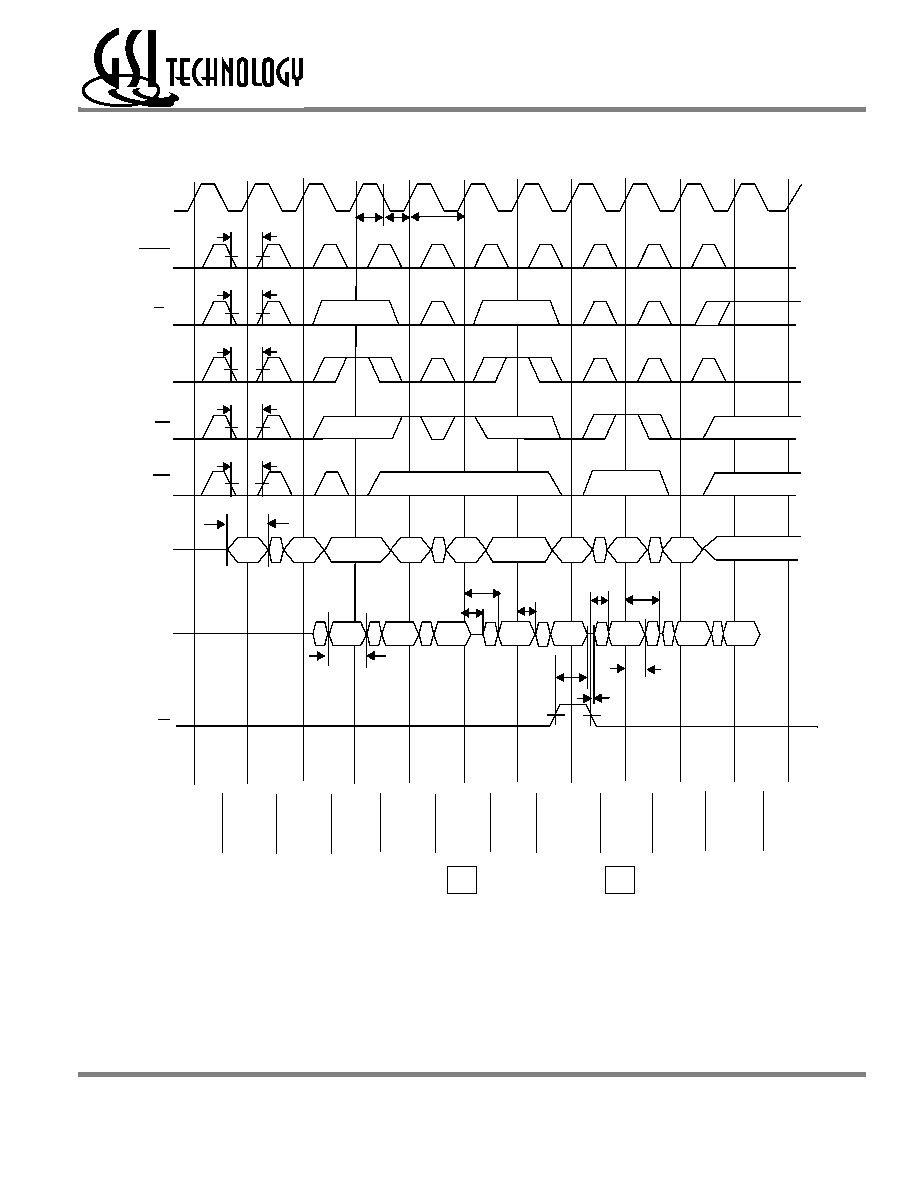
Rev: 1.01c 11/2002
17/30
© 2001, Giga Semiconductor, Inc.
Specifications cited are subject to change without notice. For latest documentation see http://www.gsitechnology.com
GS841Z18/36AT-180/166/150/100
Preliminary
Pipeline Mode Read/Write Cycle Timing
*Note: E = High (False) if E
1
= 1 or E
2
= 0 or E
3
= 1
tH
tS
tH
CK
CKE
E*
ADV
tKH
W
tKL
tKC
tS
Bn
A
0
≠An
A1
tH
tS
A2
A3
D(A1)
D(A2)
Q(A3)
Q
Q(A6)
tH
tS
D
D(A5)
tKQLZ
tKQ
tKQHZ
tOEHZ
tOELZ
tKQX
tKHQZ
tGLQV
G
1
2
3
4
5
6
7
8
9
10
COMMAND
Write
D(A1)
Write
D(A2)
BURST
Write
D(A2+1)
Read
Q(A3)
Read
Q(A4)
BURST
Read
Q(A4+1)
Write
D(A5)
Read
Q(A6)
Write
D(A7)
DESELECT
DON'T CARE
UNDEFINED
DQ
A
≠DQ
D
tH
tS
tH
tS
tH
tS
A4
A5
A6
A7
Q(A4)
(A4+1)
(A2+1)
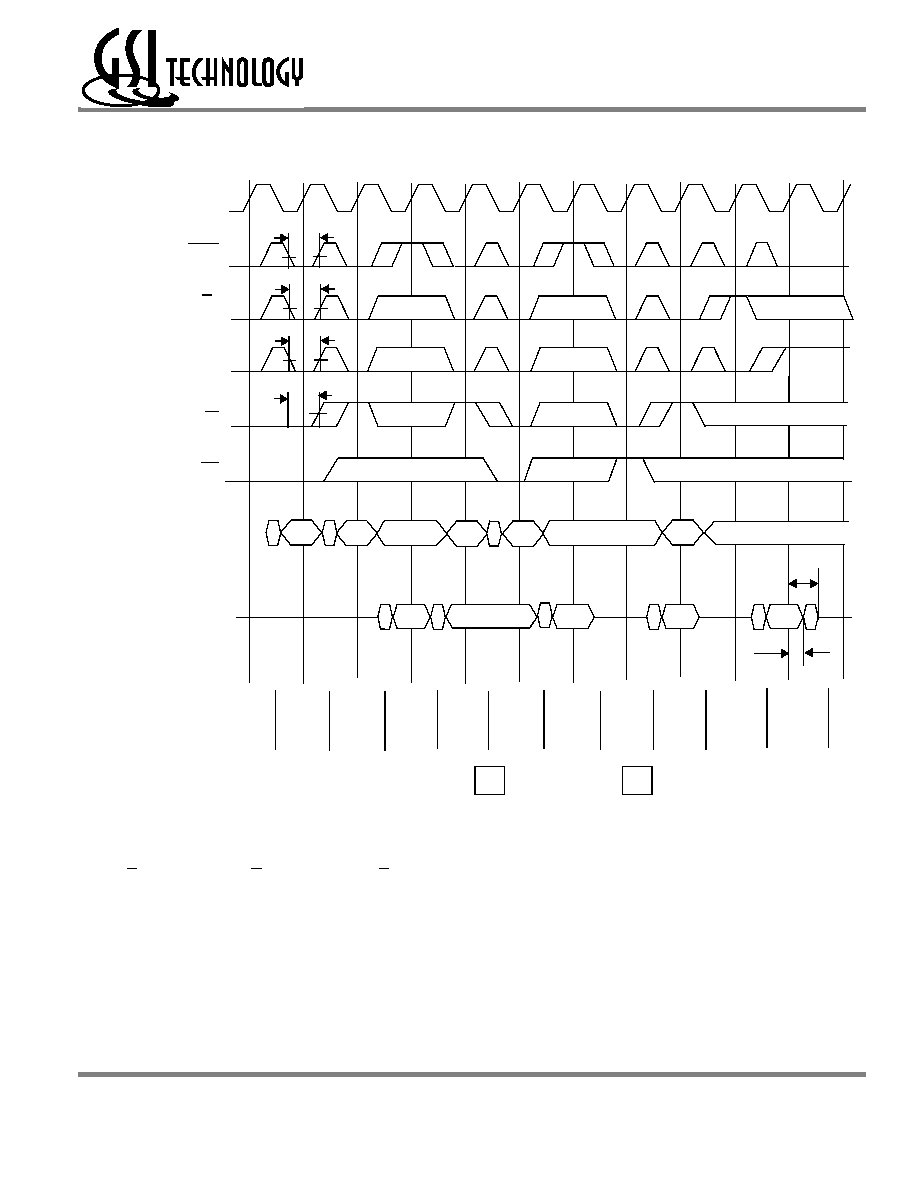
Rev: 1.01c 11/2002
18/30
© 2001, Giga Semiconductor, Inc.
Specifications cited are subject to change without notice. For latest documentation see http://www.gsitechnology.com
GS841Z18/36AT-180/166/150/100
Preliminary
Pipeline Mode No-Op, Stall and Deselect Timing
*Note: E = High (False) if E
1
= 1 or E
2
= 0 or E
3
= 1
CK
CKE
E
*
ADV
W
Bn
A
0
≠
An
A1
A5
D(A1)
Q(A2)
Q(A3)
Q(A5)
DQ
1
2
3
4
5
6
7
8
9
10
COMMAND
Write
D(A1)
Read
Q(A2)
STALL
Read
Q(A3)
Write
D(A4)
STALL
NOP
Read
Q(A5)
CONTINUE
DON'T CARE
UNDEFINED
D(A4)
tKHQZ
tKQHZ
DESELECT
DESELECT
tH
tS
A2
A3
A4
tH
tS
tH
tS
tH
tS

Rev: 1.01c 11/2002
19/30
© 2001, Giga Semiconductor, Inc.
Specifications cited are subject to change without notice. For latest documentation see http://www.gsitechnology.com
GS841Z18/36AT-180/166/150/100
Preliminary
Flow Through Mode Read/Write Cycle Timing
*Note: E = High (False) if E
1
= 1 or E
2
= 0 or E
3
= 1
CK
CKE
E*
ADV
tKH
W
tKL
tKC
Bn
A
0
≠An
tH
tS
A7
DQ
1
2
3
4
5
6
7
8
9
10
COMMAND
Write
D(A1)
Write
D(A2)
BURST
Write
D(A2+1)
Read
Q(A3)
Read
Q(A4)
BURST
Read
Q(A4+1)
Write
D(A5)
Read
Q(A6)
Write
D(A7)
DESELECT
DON'T CARE
UNDEFINED
tH
tS
tH
tS
tH
tS
tH
tS
tH
tS
A1
A2
A3
A4
A5
A6
D(A1)
D(A2)
Q(A3)
Q
Q(A6)
tH
tS
D
D(A5)
tKQLZ
tKQ
tKQHZ
tOEHZ
tOELZ
tKQX
tKHQZ
tGLQV
Q(A4)
(A4+1)
(A2+1)
G

Rev: 1.01c 11/2002
20/30
© 2001, Giga Semiconductor, Inc.
Specifications cited are subject to change without notice. For latest documentation see http://www.gsitechnology.com
GS841Z18/36AT-180/166/150/100
Preliminary
Flow Through Mode No-Op, Stall and Deselect Timing
*Note: E = High (False) if E
1
= 1 or E
2
= 0 or E
3
= 1
CK
CKE
E
*
ADV
W
Bn
A
0
≠
An
Q(A5)
DQ
1
2
3
4
5
6
7
8
9
10
COMMAND
Write
D(A1)
Read
Q(A2)
STALL
Read
Q(A3)
Write
D(A4)
STALL
NOP
Read
Q(A5)
CONTINUE
DON'T CARE
UNDEFINED
D(A4)
tKHQZ
tKQHZ
DESELECT
DESELECT
D(A1)
Q(A2)
Q(A3)
A1
A5
A2
A3
A4
tH
tS
tH
tS
tH
tS
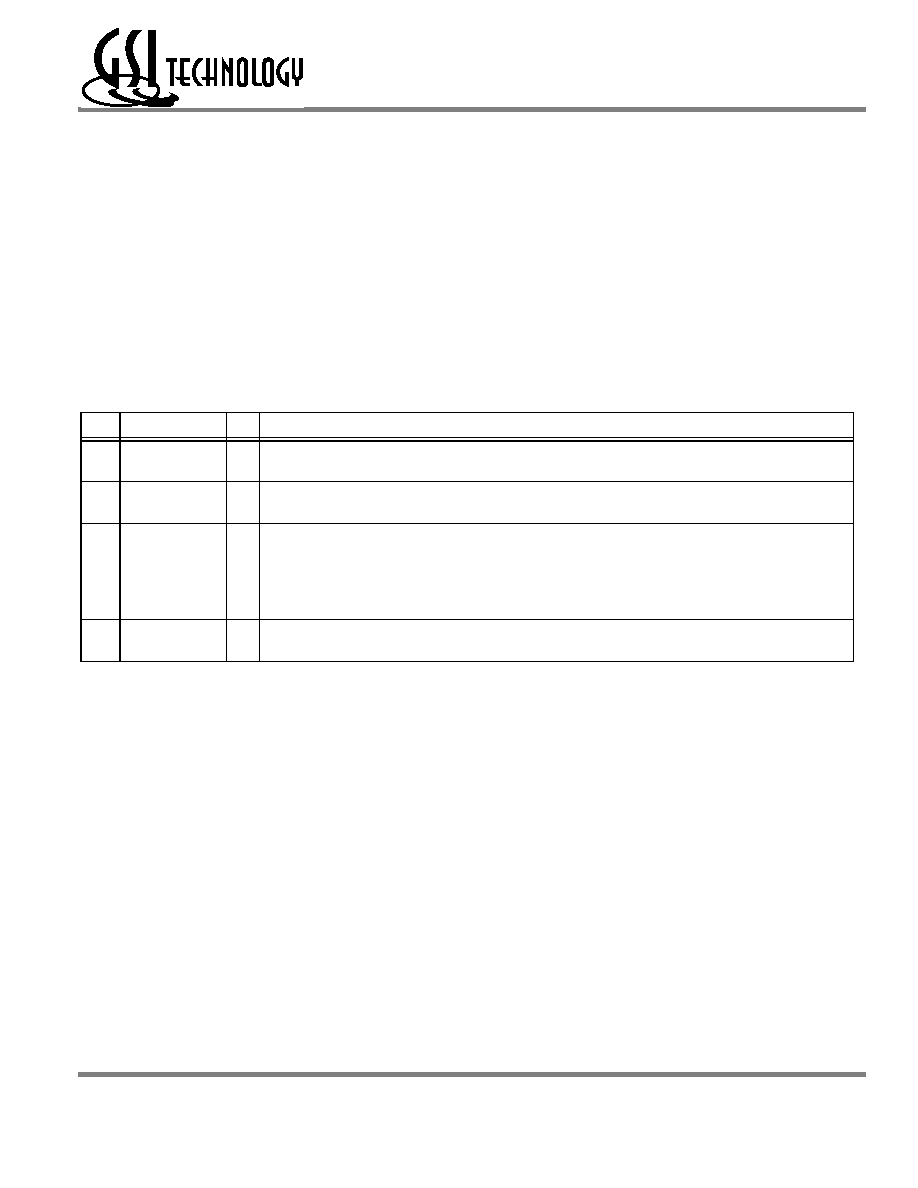
Rev: 1.01c 11/2002
21/30
© 2001, Giga Semiconductor, Inc.
Specifications cited are subject to change without notice. For latest documentation see http://www.gsitechnology.com
GS841Z18/36AT-180/166/150/100
Preliminary
JTAG Port Operation
Overview
The JTAG Port on this RAM operates in a manner consistent with IEEE Standard 1149.1-1990, a serial boundary scan interface
standard (commonly referred to as JTAG), but does not implement all of the functions required for 1149.1 compliance. Some
functions have been modified or eliminated because they can slow the RAM. Nevertheless, the RAM supports 1149.1-1990 TAP
(Test Access Port) Controller architecture, and can be expected to function in a manner that does not conflict with the operation of
Standard 1149.1 compliant devices. The JTAG Port interfaces with conventional TTL / CMOS logic level signaling.
Disabling the JTAG Port
It is possible to use this device without utilizing the JTAG port. The port is reset at power-up and will remain inactive unless
clocked. TCK, TDI, and TMS are designed with internal pull-up circuits. To assure normal operation of the RAM with the JTAG
Port unused, TCK, TDI, and TMS may be left floating or tied to either V
DD
or V
SS
. TDO should be left unconnected.
JTAG Port Registers
Overview
The various JTAG registers, refered to as TAP Registers, are selected (one at a time) via the sequences of 1s and 0s applied to TMS
as TCK is strobed. Each of the TAP Registers are serial shift registers that capture serial input data on the rising edge of TCK and
push serial data out on the next falling edge of TCK. When a register is selected it is placed between the TDI and TDO pins.
Instruction Register
The Instruction Register holds the instructions that are executed by the TAP controller when it is moved into the Run, Test/Idle or
the various data register states. Instructions are 3 bits long. The Instruction Register can be loaded when it is placed between the
TDI and TDO pins. The Instruction Register is automatically preloaded with the IDCODE instruction at power-up or whenever the
controller is placed in Test-Logic-Reset state.
Bypass Register
The Bypass Register is a single-bit register that can be placed between TDI and TDO. It allows serial test data to be passed through
the RAMs JTAG Port to another device in the scan chain with as little delay as possible.
JTAG Pin Descriptions
Pin
Pin Name
I/O
Description
TCK
Test Clock
In
Clocks all TAP events. All inputs are captured on the rising edge of TCK and all outputs propagate from the
falling edge of TCK.
TMS Test Mode Select
In
The TMS input is sampled on the rising edge of TCK. This is the command input for the TAP controller state
machine. An undriven TMS input will produce the same result as a logic one input level.
TDI
Test Data In
In
The TDI input is sampled on the rising edge of TCK. This is the input side of the serial registers placed
between TDI and TDO. The register placed between TDI and TDO is determined by the state of the TAP
Controller state machine and the instruction that is currently loaded in the TAP Instruction Register (refer to
the TAP Controller State Diagram). An undriven TDI pin will produce the same result as a logic one input
level.
TDO
Test Data Out
Out
Output that is active depending on the state of the TAP state machine. Output changes in response to the
falling edge of TCK. This is the output side of the serial registers placed between TDI and TDO.
Note:
This device does not have a TRST (TAP Reset) pin. TRST is optional in IEEE 1149.1. The Test-Logic-Reset state is entered while TMS is
held high for five rising edges of TCK. The TAP Controller is also reset automaticly at power-up.
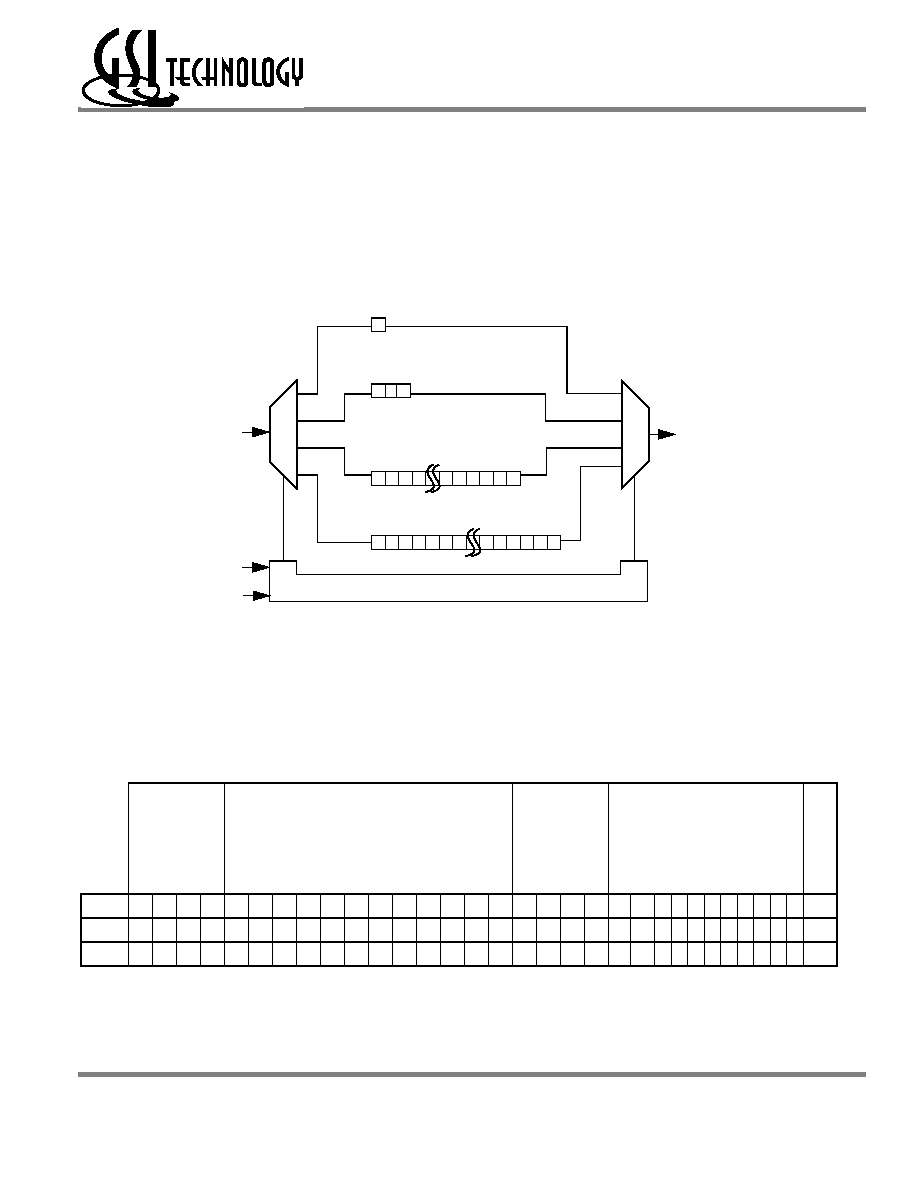
Rev: 1.01c 11/2002
22/30
© 2001, Giga Semiconductor, Inc.
Specifications cited are subject to change without notice. For latest documentation see http://www.gsitechnology.com
GS841Z18/36AT-180/166/150/100
Preliminary
Boundary Scan Register
Boundary Scan Register is a collection of flip flops that can be preset by the logic level found on the RAM's input or I/O pins. The
flip flops are then daisy chained together so the levels found can be shifted serially out of the JTAG Port's TDO pin. The Boundary
Scan Register also includes a number of place holder flip flops (always set to a logic 1). The relationship between the device pins
and the bits in the Boundary Scan Register is described in the Scan Order Table following. The Boundary Scan Register, under the
control of the TAP Controller, is loaded with the contents of the RAMs I/O ring when the controller is in Capture-DR state and then
is placed between the TDI and TDO pins when the controller is moved to Shift-DR state. Two TAP instructions can be used to
activate the Boundary Scan Register.
JTAG TAP Block Diagram
Identification (ID) Register
The ID Register is a 32-bit register that is loaded with a device and vendor specific 32-bit code when the controller is put in
Capture-DR state with the IDCODE command loaded in the Instruction Register. The code is loaded from a 32-bit on-chip ROM.
It describes various attributes of the RAM as indicated below. The register is then placed between the TDI and TDO pins when the
controller is moved into Shift-DR state. Bit 0 in the register is the LSB and the first to reach TDO when shifting begins.
Tap Controller Instruction Set
Overview
There are two classes of instructions defined in the Standard 1149.1-1990; the standard (Public) instructions, and device specific
ID Register Contents
Die
Revision
Code
Not Used
I/O
Configuration
GSI Technology
JEDEC Vendor
ID Code
Presence Register
Bit # 31 30 29 28 27 26 25 24 23 22 21 20 19 18 17 16 15 14 13 12 11 10 9 8 7 6 5 4 3 2 1
0
x36
X X X X 0
0
0
0
0
0
0
0
0
0
0
0
0
0
0
1 0 0 0 1 1 0 1 1 0 0 1
1
x18
X X X X 0
0
0
0
0
0
0
0
0
0
0
0
0
0
1
1 0 0 0 1 1 0 1 1 0 0 1
1
Instruction Register
ID Code Register
Boundary Scan Register
0
1
2
0
1
2
∑
∑ ∑ ∑
31 30 29
0
1
2
∑ ∑ ∑
∑ ∑ ∑
∑ ∑ ∑
n
0
Bypass Register
TDI
TDO
TMS
TCK
Test Access Port (TAP) Controller

Rev: 1.01c 11/2002
23/30
© 2001, Giga Semiconductor, Inc.
Specifications cited are subject to change without notice. For latest documentation see http://www.gsitechnology.com
GS841Z18/36AT-180/166/150/100
Preliminary
(Private) instructions. Some Public instructions, are mandatory for 1149.1 compliance. Optional Public instructions must be
implemented in prescribed ways. Although the TAP controller in this device follows the 1149.1 conventions, it is not 1194.1-
compliant because some of the mandatory instructions are not fully implemented. The TAP on this device may be used to monitor
all input and I/O pads, but cannot be used to load address, data or control signals into the RAM or to preload the I/O buffers.This
device will not perform EXTEST, INTEST or the SAMPLE/PRELOAD command.
When the TAP controller is placed in Capture-IR state the two least significant bits of the instruction register are loaded with 01.
When the controller is moved to the Shift-IR state the Instruction Register is placed between TDI and TDO. In this state the desired
instruction is serially loaded through the TDI input (while the previous contents are shifted out at TDO). For all instructions, the
TAP executes newly loaded instructions only when the controller is moved to Update-IR state. The TAP instruction set for this
device is listed in the following table.
JTAG Tap Controller State Diagram
Instruction Descriptions
BYPASS
When the BYPASS instruction is loaded in the Instruction Register the Bypass Register is placed between TDI and TDO. This occurs when
the TAP controller is moved to the Shift-DR state. This allows the board level scan path to be shortened to facilitate testing of other devices
in the scan path.
SAMPLE/PRELOAD
SAMPLE/PRELOAD is a Standard 1149.1 mandatory public instruction. When the SAMPLE/PRELOAD instruction is loaded in the Instruc-
tion Register, moving the TAP controller into the Capture-DR state loads the data in the RAMs input and I/O buffers into the Boundary Scan
Select DR
Capture DR
Shift DR
Exit1 DR
Pause DR
Exit2 DR
Update DR
Select IR
Capture IR
Shift IR
Exit1 IR
Pause IR
Exit2 IR
Update IR
Test Logic Reset
Run Test Idle
0
0
1
0
1
1
0
0
1
1
1
0
0
1
1
0
0
0
0
1
1
0
0
1
1
0
0
0
1
1
1
1
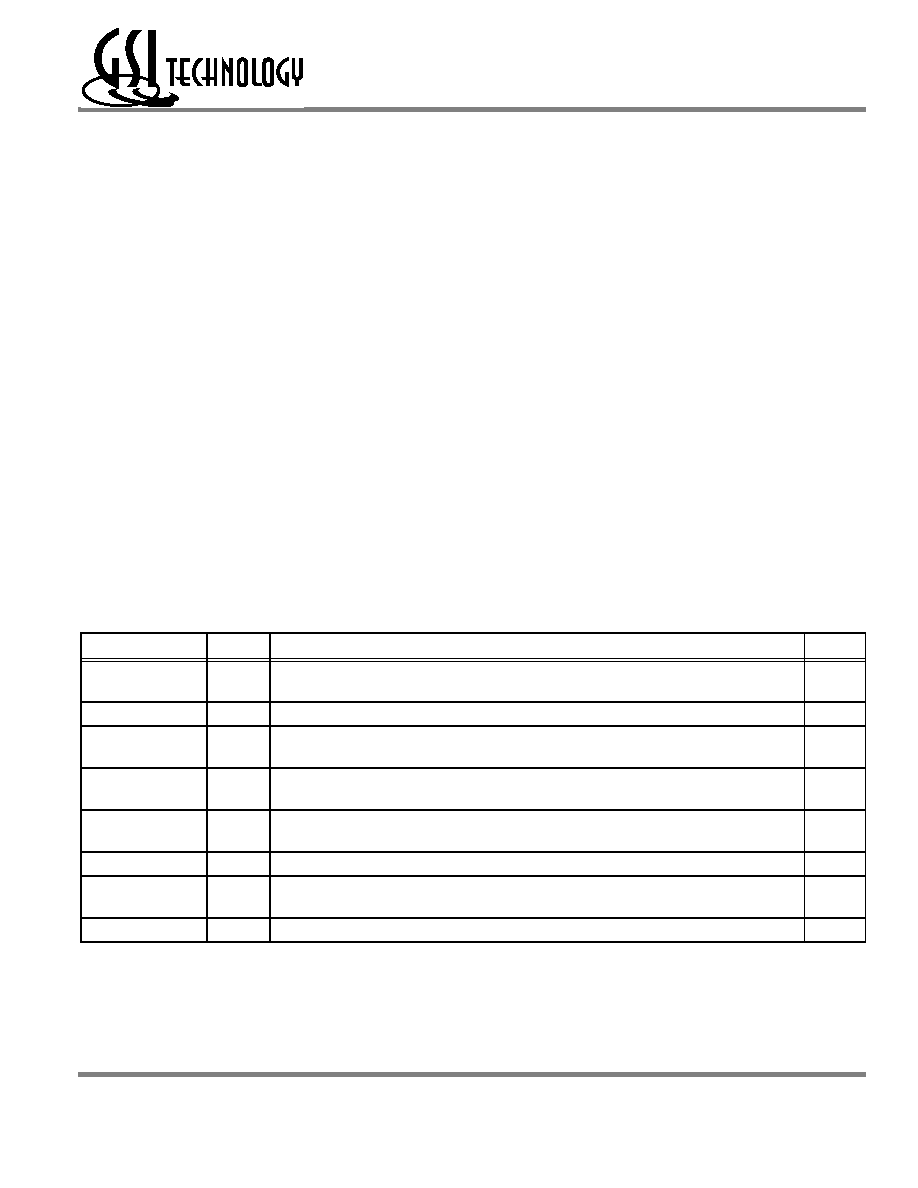
Rev: 1.01c 11/2002
24/30
© 2001, Giga Semiconductor, Inc.
Specifications cited are subject to change without notice. For latest documentation see http://www.gsitechnology.com
GS841Z18/36AT-180/166/150/100
Preliminary
Register. Because the RAM clock is independent from the TAP Clock (TCK) it is possible for the TAP to attempt to capture the I/O ring con-
tents while the input buffers are in transition (i.e. in a metastable state). Although allowing the TAP to sample metastable inputs will not harm
the device, repeatable results cannot be expected. RAM input signals must be stabilized for long enough to meet the TAPs input data cap-
ture set-up plus hold time (tTS plus tTH ). The RAMs clock inputs need not be paused for any other TAP operation except capturing the I/O
ring contents into the Boundary Scan Register. Moving the controller to Shift-DR state then places the boundary scan register between the
TDI and TDO pins. Because the PRELOAD portion of the command is not implemented in this device, moving the controller to the Update-
DR state with the SAMPLE / PRELOAD instruction loaded in the Instruction Register has the same effect as the Pause-DR command. This
functionality is not Standard 1149.1-compliant.
EXTEST
EXTEST is an IEEE 1149.1 mandatory public instruction. It is to be executed whenever the instruction register, whatever length it may be in
the device, is loaded with all logic 0s. EXTEST is not implemented in this device. Therefore, this device is not 1149.1-compliant. Neverthe-
less, this RAM's TAP does respond to an all zeros instruction, as follows. With the EXTEST (000) instruction loaded in the instruction regis-
ter the RAM responds just as it does in response to the BYPASS instruction described above.
IDCODE
The IDCODE instruction causes the ID ROM to be loaded into the ID register when the controller is in Capture-DR mode and places the ID
register between the TDI and TDO pins in Shift-DR mode. The IDCODE instruction is the default instruction loaded in at power up and any
time the controller is placed in the Test-Logic-Reset state.
SAMPLE-Z
If the SAMPLE-Z instruction is loaded in the instruction register, all RAM outputs are forced to an inactive drive state (high-Z) and the Bound-
ary Scan Register is connected between TDI and TDO when the TAP controller is moved to the Shift-DR state.
RFU
These instructions are Reserved for Future Use. In this device they replicate the BYPASS instruction.
JTAG TAP Instruction Set Summary
Instruction
Code
Description
Notes
EXTEST
000
Replicates BYPASS instruction. Places Bypass Register between TDI and TDO.
This RAM does not implement 1149.1 EXTEST function. *Not 1149.1 Compliant *
1
IDCODE
001
Preloads ID Register and places it between TDI and TDO.
1, 2
SAMPLE-Z
010
Captures I/O ring contents. Places the Boundary Scan Register between TDI and TDO.
Forces all RAM output drivers to High-Z.
1
RFU
011
Do not use this instruction; Reserved for Future Use.
Replicates BYPASS instruction. Places Bypass Register between TDI and TDO.
1
SAMPLE/
PRELOAD
100
Captures I/O ring contents. Places the Boundary Scan Register between TDI and TDO.
This RAM does not implement 1149.1 PRELOAD function. *Not 1149.1 Compliant *
1
GSI
101
GSI private instruction.
1
RFU
110
Do not use this instruction; Reserved for Future Use.
Replicates BYPASS instruction. Places Bypass Register between TDI and TDO.
1
BYPASS
111
Places Bypass Register between TDI and TDO.
1
Notes:
1. Instruction codes expressed in binary, MSB on left, LSB on right.
2. Default instruction automatically loaded at power-up and in test-logic-reset state.

Rev: 1.01c 11/2002
25/30
© 2001, Giga Semiconductor, Inc.
Specifications cited are subject to change without notice. For latest documentation see http://www.gsitechnology.com
GS841Z18/36AT-180/166/150/100
Preliminary
JTAG Port Recommended Operating Conditions and DC Characteristics
Parameter
Symbol Min.
Max.
Unit Notes
Test Port Input High Voltage
V
IHT
1.7
V
DD
+0.3
V
1, 2
Test Port Input Low Voltage
V
ILT
≠0.3
0.8
V
1, 2
TMS, TCK and TDI Input Leakage Current
I
INTH
≠300
1
uA
3
TMS, TCK and TDI Input Leakage Current
I
INTL
≠1
1
uA
4
TDO Output Leakage Current
I
OLT
≠1
1
uA
5
Test Port Output High Voltage
V
OHT
2.4
--
V
6, 7
Test Port Output Low Voltage
V
OLT
--
0.4
V
6, 8
Notes:
1. This device features input buffers compatible with both 3.3 V and 2.5 V I/O drivers.
2. Input Under/overshoot voltage must be ≠2 V > Vi < V
DD
+2 V with a pulse width not to exceed 20%
tTKC.
3. V
DD
V
IN
V
IL
4. 0 V
V
IN
V
IL
5. Output Disable, V
OUT
= 0 to V
DD
6. The TDO output driver is served by the V
DD
supply.
7. I
OH
= ≠4 mA
8. I
OL
= +4 mA
Notes:
1. Include scope and jig capacitance.
JTAG Port AC Test Conditions
Parameter
Conditions
Input high level
2.3 V
Input low level
0.2 V
Input slew rate
1 V/ns
Input reference level
1.25 V
Output reference level
1.25 V
DQ
V
T
= 1.25 V
50
30pF
*
JTAG Port AC Test Load
* Distributed Test Jig Capacitance
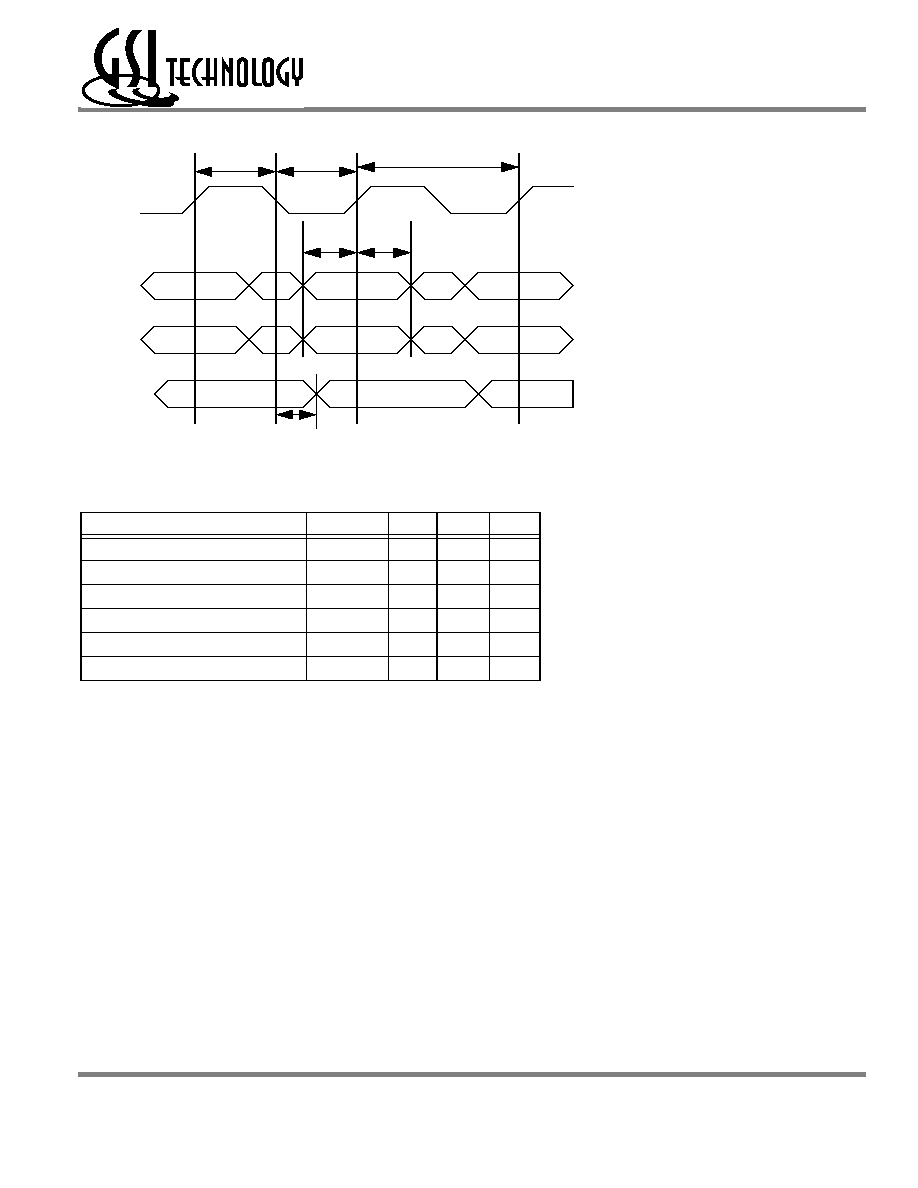
Rev: 1.01c 11/2002
26/30
© 2001, Giga Semiconductor, Inc.
Specifications cited are subject to change without notice. For latest documentation see http://www.gsitechnology.com
GS841Z18/36AT-180/166/150/100
Preliminary
JTAG Port Timing Diagram
JTAG Port AC Electrical Characteristics
Parameter
Symbol
Min
Max
Unit
TCK Cycle Time
tTKC
20
--
ns
TCK Low to TDO Valid
tTKQ
--
10
ns
TCK High Pulse Width
tTKH
10
--
ns
TCK Low Pulse Width
tTKL
10
--
ns
TDI & TMS Set Up Time
tTS
5
--
ns
TDI & TMS Hold Time
tTH
5
--
ns
tTKQ
tTS
tTH
tTKH
tTKL
TCK
TMS
TDI
TDO
tTKC

Rev: 1.01c 11/2002
27/30
© 2001, Giga Semiconductor, Inc.
Specifications cited are subject to change without notice. For latest documentation see http://www.gsitechnology.com
GS841Z18/36AT-180/166/150/100
Preliminary
Output Driver Characteristics
BPR 1999.05.18
-140.0
-120.0
-100.0
-80.0
-60.0
-40.0
-20.0
0.0
20.0
40.0
60.0
80.0
100.0
120.0
-0.5
0
0.5
1
1.5
2
2.5
3
3.5
4
V Out (Pull Down)
VDDQ - V Out (Pull Up)
I Out (mA)
3.6V PD HD
3.3V PD HD
3.1V PD HD
3.1V PU HD
3.3V PU HD
3.6V PU HD
Pull Up Drivers
Pull Down Drivers
VD D Q
VO ut
I
O ut
VS S

Rev: 1.01c 11/2002
28/30
© 2001, Giga Semiconductor, Inc.
Specifications cited are subject to change without notice. For latest documentation see http://www.gsitechnology.com
GS841Z18/36AT-180/166/150/100
Preliminary
TQFP Package Drawing
BPR 1999.05.18
D1
D
E1
E
Pin 1
b
e
c
L
L1
A2
A1
Y
Notes:
1. All dimensions are in millimeters (mm).
2. Package width and length do not include mold protrusion.
Symbol
Description
Min. Nom. Max
A1
Standoff
0.05
0.10
0.15
A2
Body Thickness
1.35
1.40
1.45
b
Lead Width
0.20
0.30
0.40
c
Lead Thickness
0.09
--
0.20
D
Terminal Dimension
21.9
22.0
22.1
D1
Package Body
19.9
20.0
20.1
E
Terminal Dimension
15.9
16.0
16.1
E1
Package Body
13.9
14.0
14.1
e
Lead Pitch
--
0.65
--
L
Foot Length
0.45
0.60
0.75
L1
Lead Length
--
1.00
--
Y
Coplanarity
--
--
0.10
Lead Angle
0
∞
--
7
∞

Rev: 1.01c 11/2002
29/30
© 2001, Giga Semiconductor, Inc.
Specifications cited are subject to change without notice. For latest documentation see http://www.gsitechnology.com
GS841Z18/36AT-180/166/150/100
Preliminary
Ordering Information--GSI NBT Synchronous SRAM
Org
Part Number
1
Type
Package
Speed
2
(MHz/ns)
T
A
3
Status
256K x 18
GS841Z18AT-180
NBT Pipeline/Flow Through
TQFP
180/8
C
256K x 18
GS841Z18AT-166
NBT Pipeline/Flow Through
TQFP
166/8.5
C
256K x 18
GS841Z18AT-150
NBT Pipeline/Flow Through
TQFP
150/10
C
256K x 18
GS841Z18AT-100
NBT Pipeline/Flow Through
TQFP
100/12
C
128K x 36
GS841Z36AT-180
NBT Pipeline/Flow Through
TQFP
180/8
C
128K x 36
GS841Z36AT-166
NBT Pipeline/Flow Through
TQFP
166/8.5
C
128K x 36
GS841Z36AT-150
NBT Pipeline/Flow Through
TQFP
150/10
C
128K x 36
GS841Z36AT-100
NBT Pipeline/Flow Through
TQFP
100/12
C
256K x 18
GS841Z18AT-180I
NBT Pipeline/Flow Through
TQFP
180/8
I
256K x 18
GS841Z18AT-166I
NBT Pipeline/Flow Through
TQFP
166/8.5
I
256K x 18
GS841Z18AT-150I
NBT Pipeline/Flow Through
TQFP
150/10
I
256K x 18
GS841Z18AT-100I
NBT Pipeline/Flow Through
TQFP
100/12
I
128K x 36
GS841Z36AT-180I
NBT Pipeline/Flow Through
TQFP
180/8
I
128K x 36
GS841Z36AT-166I
NBT Pipeline/Flow Through
TQFP
166/8.5
I
128K x 36
GS841Z36AT-150I
NBT Pipeline/Flow Through
TQFP
150/10
I
128K x 36
GS841Z36AT-100I
NBT Pipeline/Flow Through
TQFP
100/12
I
Notes:
1. Customers requiring delivery in Tape and Reel should add the character "T" to the end of the part number. Example: GS8Z36A-100IT.
2. The speed column indicates the cycle frequency (MHz) of the device in Pipeline mode and the latency (ns) in Flow Through mode. Each
device is Pipeline/Flow Through mode-selectable by the user.
3. T
A
= C = Commercial Temperature Range. T
A
= I = Industrial Temperature Range.
4. GSI offers other versions this type of device in many different configurations and with a variety of different features, only some
of which are covered in this data sheet. See the GSI Technology web site (www.gsitechnology.com) for a complete listing of current offerings

Rev: 1.01c 11/2002
30/30
© 2001, Giga Semiconductor, Inc.
Specifications cited are subject to change without notice. For latest documentation see http://www.gsitechnology.com
GS841Z18/36AT-180/166/150/100
Preliminary
4Mb Synchronous NBT Datasheet Revision History
DS/DateRev. Code: Old;
New
Types of Changes
Format or Content
Page /Revisions/Reason
841Z18A_r1
∑ Creation of new datasheet
841Z18A_r1;
841Z18A_r1_01
Content
∑ Changed description of E2 in pin description table (from active
low to active high)
∑ Removed pin locations from pin description table
∑ Removed 200 MHz speed bin





























